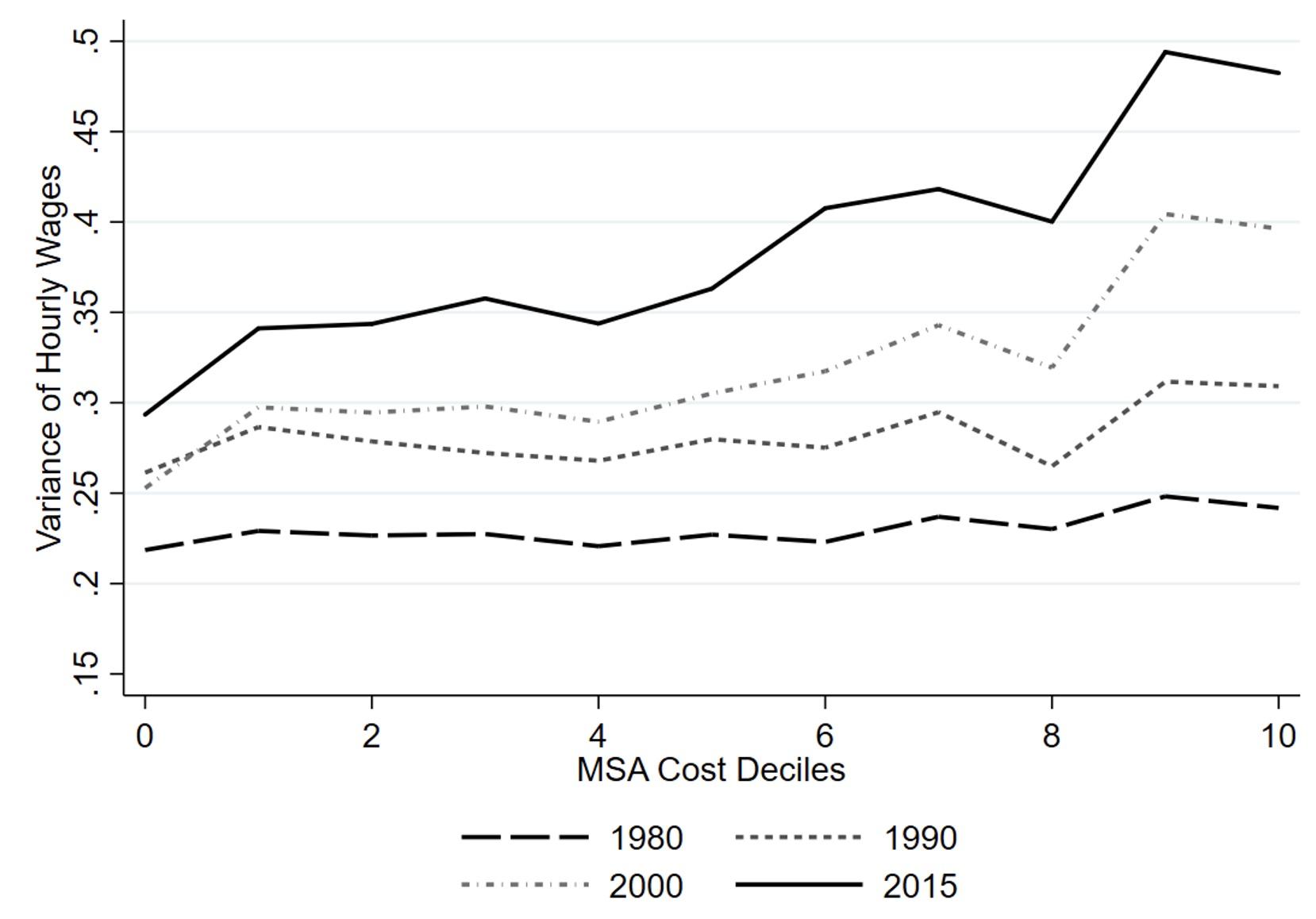Mobile dating apps work better in dense urban areas. The same goes for information technology (IT), and this has profound implications for inequality and polarisation in the labour market. Polarisation has a marked geographical dimension (Autor 2019, Autor and Dorn 2013, Rossi-Hansberg et al. 2019), yet little is known about the mechanism that links investment in IT and job displacement across space. Much of the benefit of investment by firms in hardware and software comes from labour savings that these technologies bring (e.g. Atalay et al. 2020). This column discusses new evidence that those labour savings are largest in dense, urban areas – basically big cities and metropolitan areas – and therefore, urban firms have the biggest incentives to invest in those labour-saving technologies.
There are two reasons why firms in big cities invest more in labour-saving IT. It is a tale of two prices: the wage cost of labour and the price of IT. Wages are systematically higher in bigger cities. This is known as the urban-wage premium, which in the US has an elasticity of around 4.5%. As the size of a city doubles, wages increase by 4.5%. That implies that average wages in New York, NY are about 35% higher than in Janesville, WI, simply because New York with a population of 20 million is 125 times larger than Janesville with a population of 163,000. The urban wage premium is the response of the wage to higher housing costs in big cities. And big cities are more expensive because they are more productive. All else equal, if wages were the same, workers would prefer to live in the cheaper small cities.
Instead, the price of IT is very similar everywhere, in New York and in Janesville. These IT technologies are nearly perfectly tradable, where software is increasingly installed online, hardware is shipped by courier, and technical support is done remotely. As a result, the price of IT as a tradable good is independent of the location of the firm.
So with the cost of comparable labour higher in big cities, and the cost of IT technologies the same, firms invest disproportionately in IT in big cities. Now the adoption of new technologies varies by the type of job, in particular, whether they are routine occupations. This affects the composition of skills (job polarisation) within and between cities, and it has implications for wage inequality (wage polarisation).
This economic mechanism driven by price differences is exactly what we corroborate in the data. In a new paper (Eeckhout et al. 2021), we use a novel dataset, the Ci Technology Database from the Aberdeen Group, with detailed hardware and software information for over 200,000 establishments to test this hypothesis and how polarisation has evolved since 1990. Using information on the total IT budget per worker as well as on the expenditure and adoption of Enterprise Resource Planning (ERP) software, we establish two robust stylised facts. First, IT investment is highest in firms located in cities with high housing costs. Figure 1 illustrates that the cities such as New York and San Francisco with the highest rent index spend over 50% more on IT per worker than cities like Janesville and Springfield. We confirm the robustness of this finding with different regression specifications.
Figure 1 Average IT per worker versus local price level
Second, the share of workers employed in clerical occupations (routine cognitive occupations) declines faster in expensive cities. These are the occupations whose tasks are most likely to be displaced by technology. Over the period 1990 to 2015 there has been an economy-wide decline in routine cognitive employment, which has been documented extensively (see amongst others, Acemoglu and Autor 2011, Cortes et al. 2014, Goos et al. 2014). Our regressions show that this decline in routine-cognitive occupations is largest in those cities with the highest rent index. The most expensive cities see a 4.5% drop in the share of routine-cognitive occupations compared to the cheapest locations, or one quarter of the economy-wide average share in 2015.
These two new stylised facts also are key to understanding the evolution of wage inequality since 1980. In line with earlier work (Baum-Snow and Pavan 2013, Eeckhout et al. 2014, Santamaria 2018) that documents the variation in wage inequality between and within cities, we find that wage inequality is larger within larger cities, but that was not the case in 1980. Figure 2 shows that the variance in 2015 is increasing from 0.3 in the cheapest cities to nearly 0.5 in the most expensive ones. In 1980 the variance was hovering around 0.21–0.22 across all cities. So inequality is now a lot higher everywhere (the variance nearly doubles for the median cost city) and inequality is increasing in cost. At the same time, the inequality between cities which can be measured by the urban wage premium has not changed over time. A variance decomposition of wages shows that 95% of the variance in hourly wages is within cities and 5% between, with no change over time.
Figure 2 Variance of city wages by the city’s housing cost
In order to evaluate the effect of policy interventions and to calculate the welfare impact, we propose a spatial equilibrium model that rationalises these stylised facts. In the model mechanism, the substitution of routine workers by IT leads to higher IT adoption in large cities due to a higher cost of living and higher wages. We estimate the model to trace out the effects of IT on the labour market between 1990 and 2015. We find that the fall in IT prices explains 50% of the rising wage gap between routine and non-routine cognitive jobs. The decline in IT prices also accounts for 28% of the shift in employment away from routine cognitive towards non-routine cognitive jobs. Moreover, our estimates show that the impact of IT is uneven across space. Expensive locations have seen a stronger displacement of routine cognitive jobs and a larger widening of the wage gap between routine and non-routine cognitive jobs.
Polarisation via the displacement of routine cognitive jobs is driven by the adoption of IT in the workplace. Krusell et al. (2000) show that the differential adoption of technology is an important force behind the rise in inequality between skilled and unskilled workers. Our results show that technology adoption also plays a key role in polarisation across cities with different costs of living. Lower relative prices of the new technology compared to the cost of labour lead to different investment choices by urban firms. This in turn leads to the polarisation of occupations across geography and accounts for the rise in wage inequality within cities. In sum, polarisation and inequality is an urban affair, driven by new technologies that thrive in dense and large cities. Just like mobile dating.
Authors' note: The views in this column are those of the authors and do not necessarily reflect the views of the Federal Reserve System, the Federal Reserve Bank of Cleveland, or the Board of Governors.
References
Acemoglu, D and D H Autor (2011), “Skills, tasks and technologies: Implications for employment and earnings,” Handbook of Labor Economics, 4: 1043–1171.
Atalay, E, P Phongthiengtham, S Sotelo and D Tannenbaum (2020), “The changing nature of work in the US,” VoxEU.org, 23 January.
Autor, D H (2019), “Work of the past, work of the future,” AEA Papers and Proceedings, 109: 1–32.
Autor, D H and D Dorn (2013), “The growth of low-skill service jobs and the polarization of the US labor market,” The American Economic Review, 103(5): 1553–1597.
Baum-Snow, N and R Pavan (2013), “Inequality and city size,” Review of Economics and Statistics, 95(5): 1535–1548.
Cortes, M, N Jaimovich, C Nekarda and H Siu (2014), “The who and how of disappearing routine jobs,” VoxEU.org, 2 October.
Eeckhout, J, R Pinheiro and K Schmidheiny (2014), “Spatial sorting”, Journal of Political Economy, 122(3): 554–620.
Eeckhout, J, C Hedtrich and R Pinheiro (2021), “IT and Urban Polarization”, CEPR Discussion Paper No. 16540.
Goos, M, A Manning and A Salomons (2014), “Explaining job polarization: Routine-biased technological change and offshoring,” American Economic Review, 104(8): 2509–26.
Krusell, P, L E Ohanian, J-V Rios-Rull and G L Violante (2000), “Capital-skill complementarity and inequality: A macroeconomic analysis,” Econometrica, 68(5): 1029–1053.
Rossi-Hansberg, E, P-D Sarte and F Schwartzman (2019), “Optimal policy responses to the growing polarisation of occupations in space,” VoxEU.org, 29 November.
Santamaria, C (2018), “Small teams in big cities: Inequality, city size, and the organization of production,” Princeton, mimeo.








